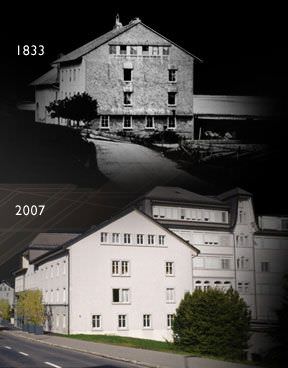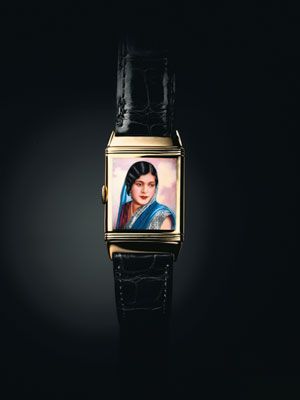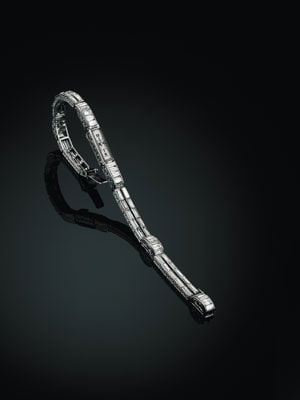Jaeger-LeCoultre recently inaugurated its Heritage Gallery. At the heart of the modern Manufacture, on the very spot where company founder Antoine LeCoultre set up his first workshop in 1833, an innovative scenography highlights 500 superb horological objects.
All have been developed and produced by Jaeger-LeCoultre. They include technical masterpieces, superlative creations, icons and over 300 different mechanical movements.
The Jaeger-LeCoultre Heritage Gallery unveils the finest collection of historical and modern Jaeger-LeCoultre watches, clocks and movements ever assembled since the birth of the “Grande Maison” in the Vallée de Joux in 1833.

Drawn from the private collection of the Manufacture, which comprises several thousand objects, over 500 technical marvels will reflect the major role played by Jaeger-LeCoultre in the history of Swiss watchmaking, and particularly in the fields of precision, functions and design.
From pocket-watches to wristwatches along with ring-, brooch- and pendant-watches, devotees of fine objects will discover timepieces spanning over a century and a half.
The grand Jaeger-LeCoultre tradition has been expressed with equal eloquence through Grande Complications, useful functions and Haute Joaillerie models. A succession of milestone creations have made their mark on each era, among them watches such as the famous Duoplan (from
1925), the Memovox line (from 1950) including the Polaris (1965), the Futurematic (from 1953) and assorted diver’s watches (from 1959). An extraordinary collection of Reverso watches dating from 1931 to the present day will turn the spotlight on the countless different faces of the legendary reversible watch.
Embodying the brand’s continuity and incredible current dynamism, exceptional contemporary models such as the Gyrotourbillon I (204) or the Reverso grande complication àtriptyque (2006) rub shoulders with vintage masterpieces. Visitors will also have a chance to discover the extraordinary history of the Atmos clock, from the 1928 prototype to the Atmos Transparente (2006).
This unique collection is displayed in Jaeger-LeCoultre’s most hallowed inner sanctum: on the exact spot where the first workshop of the Manufacture was built – the place where Antoine
LeCoultre developed his first inventions from 1833 onwards. Encompassing both past and future, the scenography pays tribute to the founder’s visionary spirit. Through their layout as well as their complexity and their innovations, the showcases clearly evoke a watch movement. Clothed in glass and leather, these authentic sculptures play on the themes of verticality and transparency. Each of them towers over two floors and such monumental displays naturally implied major technical challenges. In particular, visitors will be fascinated by the sight of an imposing curved glass wall measuring 5.4 metres wide and over 4.7 metres high. This
transparent wall contains the most extraordinary collection of watch movements ever displayed:
300 different calibres that have emerged from the Manufacture workshops between 1833 and
the present day!

Antoine LeCoultre
The second area of the Heritage Gallery consists in a temporary exhibition zone that will host several exhibitions per year dedicated to the brand’s latest creations. But to mark the inauguration of the Gallery, the first exhibition will focus on the documents relating to the
founding of Jaeger-LeCoultre within the historical context of the Vallée de Joux. From the 1559 charter recording the settlement of the first LeCoultre in the Vallée de Joux to the birth of the Manufacture, the exhibition will deal with the extraordinary watch-making destiny of this remote valley with its endless winters, in which the spirit of invention has always been the basic
prerequisite for survival.
As a new stage in the incredible horological odyssey initiated by Antoine LeCoultre, the Heritage Gallery is another landmark in the ongoing journey of the Jaeger-LeCoultre brand.
Located in the historical heart of the “Grande Maison” in the Vallée de Joux, it both reflects and perpetuates the vocation of a Manufacture, which from its earliest days has been tirelessly dedicated to inventing and to exploring new technical and aesthetic horizons. In a nutshell, to renewing the grand Swiss watchmaking tradition.

A few star items on show in the Heritage Gallery
1928 The Grande Complication pocket-watch
From the 1870s onwards, the Manufacture came to specialise in complicated calibres. Over the following 30 years, its watchmakers created 99 different repeater calibres and 128 different chronographs, including 32 equipped with split-second mechanisms and 42 with counters. The first Grande- Complications models date back to the 1890s.
Visitors to the Heritage Gallery will be especially fascinated by an exceptional piece made in 1928. The blue enamel-rimmed 18-carat yellow gold case frames an open-worked dial revealing LeCoultre Calibre 17JCSMCCRVQ. This spectacular micro-mechanical accomplishment features a minute repeater, a chronograph with counter and split-second mechanism, a perpetual calendar indicating the day, the phase and ages of the moon and the leap-year cycle. The small seconds dial is alternately graduated with the age of the moon.
Jaeger-LeCoultre Heritage, inventory no 161.

1936 Reverso portraying an Indian woman
In 1931, thanks to the unique turn of its swivel case, the Reverso was originally a successful response to the challenge launched by British army officers in India who wanted a watch able to stand up to the hard knocks of a polo match. Proving to be far more than a mere sports watch, it soon won over a refined and cosmopolitan
clientele and became a grand Art Deco classic. Today, it continues to convey the essential values of this artistic movement, including aesthetic purity, artistic craftsmanship and technical perfection dedicated to the earer’s pleasure. Among the many Reverso watches on display in the Heritage Gallery, visitors will be able to admire the oldest Reverso known to date, featuring a back personalised by an enamelled miniature. Legend has it that this unique watch was commissioned by a maharaja and the enamelled miniature depicts a stunningly beautiful woman whose identity remains shrouded in mystery to this day.
Characteristics: Enamel painting on the case-back. Jaeger-LeCoultre Calibre 410. 18-carat yellow
gold case. Jaeger-LeCoultre Heritage, inventory no. 23

1938 Joaillerie 101
In 1929, the “Grande Maison” in the Vallée de Joux invented the world’s smallest watch mechanism, Calibre 101. Measuring a mere 14 x 4.8 x 3.4 mm, it comprised 74 parts and weighed barely a gram.
Produced in an extremely small series since its creation. Calibre 101 has found its way through the decades without ever losing its record-breaking status. It currently houses 98 parts that only a handful of watchmakers are capable of assembling and adjusting.
The Heritage Gallery will present several watches equipped with Calibre 101 and spanning the entire company history from its origins to the present day, including a masterpiece dated 1938 and associating the beauty of diamonds with a virtuoso display of horology.
Characteristics: The world’s smallest mechanical movement. Jaeger-LeCoultre Calibre 101. 18-carat white gold, decorated on the sides. 63 baguette-cut diamonds, totalling approx. 12.34 carats. Jaeger-LeCoultre Heritage, inventory no. 1222

1907. Lépine pocket-watch equipped with the world’s thinnest calibre
The Jaeger-LeCoultre brand was born from the encounter between two men. In 1903, Parisian watchmaker Edmond Jaeger invited Swiss manufacturers to develop and undertake a smallseries production of the ultra-thin movements he had invented. Determined to respond to this challenge, Jacques-David LeCoultre, grandson of the founder of LeCoultre & Cie, became passionately interested in this project. Subsequent cooperation between the two men soon gave rise to the most amazing collection of ultra-thin simple and complicated movements.
Among them was LeCoultre Calibre 145, which since 1907 is still the thinnest in its category at just 1.38 mm high. Only the extraordinary convergence of skills and horological passion cultivated within the Manufacture could make such a feat possible. LeCoultre Calibre 145 was
manufactured in a small series for over half a century.
Characteristics: 1907. The world’s thinnest pocket-watch. So-called “knife” case. Lecoultre Calibre 145. 18-carat yellow gold. Jaeger-LeCoultre Heritage, inventory no. 314.

Source: Jaeger-Lecoultre
www.jaegerlecoultre.com
Contact:[email protected]
(Please credit europastar.com)





